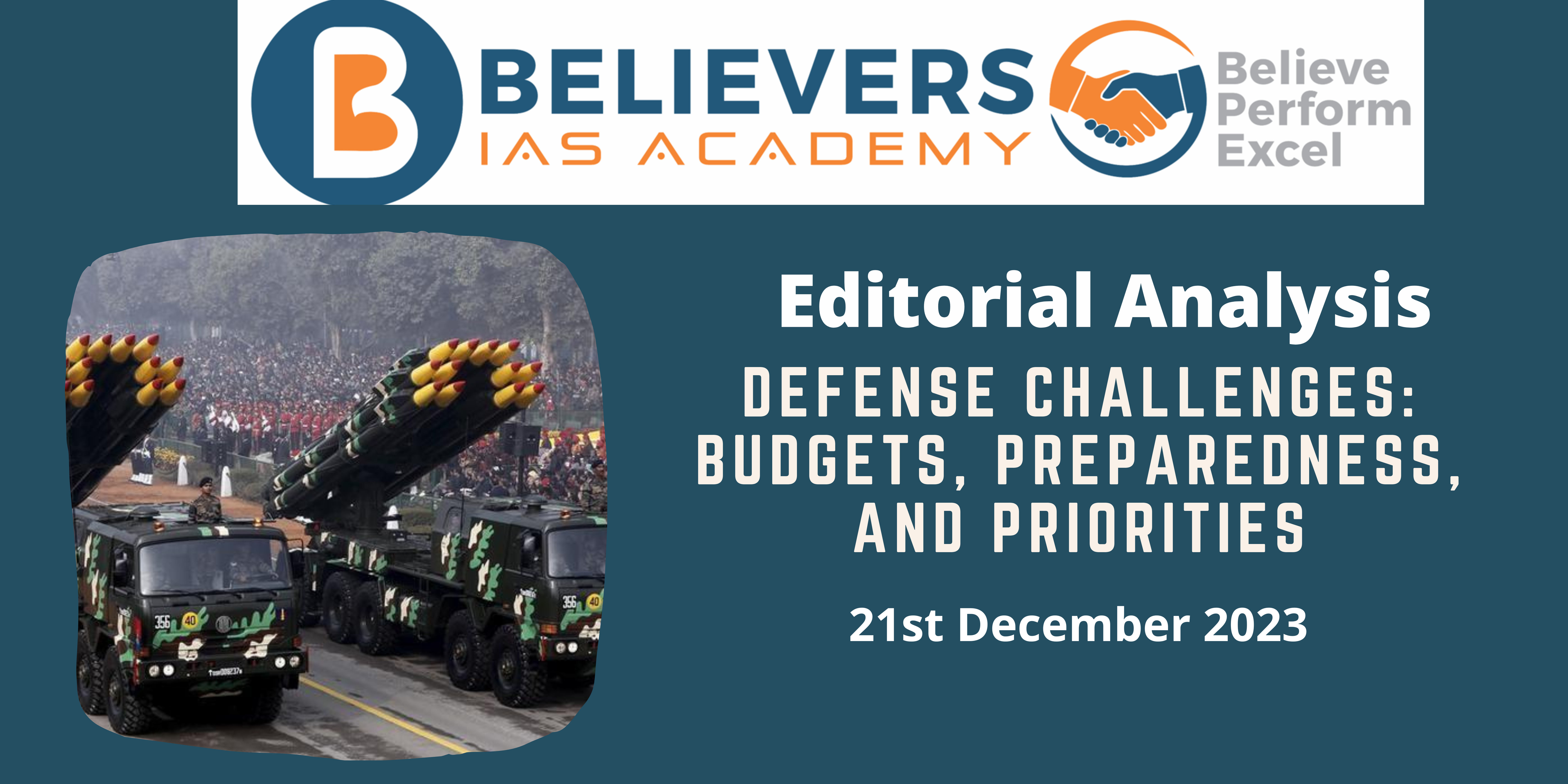Defense Challenges: Budgets, Preparedness, and Priorities
Context:
The article – “India’s defence budgeting and the point of deterrence”, delves into the complexities of India’s defense preparedness, particularly in the context of budget allocations, modernization challenges, and the need for a balanced approach between indigenous development and imports.
Relevance:
GS-3 (Security)
Main Question:
Should India’s defense budget be determined by affordability, leading to compromises in potency, or should the required potency dictate the allocation of funds, especially considering the evolving security threats? (250 words)
Dimensions of the Article:
- Highlights of the Article
- Key Challenges Behind the Defense Procurement Issue
Highlights of the Article:
- Budgetary Concerns and Procurements: Reflects on historical defense procurements, expressing worry about compromised squadron strength and potential budgetary impacts amid upcoming elections.
- Affordability vs. Effectiveness Dilemma: Raises questions about balancing affordability and effectiveness in defense budget allocations, highlighting the IAF’s choice of 97 Tejas Mk1A fighters over the planned 114 multi-role aircraft.
- Security Preparedness on Multiple Fronts: Emphasizes the need for a comprehensive assessment of India’s war strategy, advocating preparedness for security threats on both the northern and western borders.
- Technological Modernization Imperative: Underscores the importance of technological modernization, discussing challenges in developing a robust local defense industry and the need for a balanced approach.
- National Security Prioritization: Concludes by stressing the paramount importance of prioritizing national security over short-term electoral gains, cautioning against compromising defense capabilities and advocating for strategic foresight in planning.
Key Challenges Behind the Defense Procurement Issue:
- Squadron Depletion: The historical context reveals a significant shortfall in the fulfillment of defense procurement requirements, especially in the case of the Medium Multi-Role Combat Aircraft (MMRCA) program. The failure to acquire the intended number of aircraft has resulted in a substantial depletion of squadrons in the Indian Air Force (IAF), posing a critical challenge to the nation’s defense capabilities.
- Budgetary Constraints: One of the primary challenges revolves around budgetary limitations. The article highlights the perennial dilemma between ‘affordable defense’ and ‘affordable effectiveness.’ The constrained defense budget, both in real terms and as a percentage of the central government expenditure, raises concerns about the adequacy of resources allocated for defense preparedness.
- Geopolitical Threats: The live threat on India’s northern borders and the dynamic geopolitical landscape present immediate challenges. The unpredictable nature of security threats requires a comprehensive and adaptable defense strategy, necessitating constant evaluation and preparedness for potential conflicts.
- Technological Modernization: Achieving technological modernization poses a significant challenge, especially in the context of developing a robust local defense industry. Balancing the need for advanced technology with budgetary constraints and the time required for indigenous development becomes a complex task.
- Research and Development Gap: India faces a substantial gap in research and development expenditure compared to global standards. The challenge lies in enhancing investment in research and development to keep pace with technological advancements globally and ensure that defense capabilities remain cutting-edge.
- Indigenization Timeframe: While initiatives like Innovations For Defence Excellence (iDEX) and service-specific projects are commendable, the challenge lies in the extended gestation period for indigenization efforts. Building a self-reliant defense ecosystem requires sustained momentum, long-term policy commitments, and overcoming challenges associated with the complexities of defense production.
- Bipartisan Statesmanship: Ensuring election-proof defense policies demands bipartisan statesmanship. The challenge is to navigate the boisterous democratic landscape, where short-term electoral considerations might influence critical defense decisions. Achieving consensus on defense budgeting and long-term strategic priorities becomes a challenging aspect of defense planning.
- National Security vs. Electoral Gains: Balancing national security imperatives against electoral gains is a persistent challenge. The article underscores the importance of strategic foresight in defense planning and resource allocation, cautioning against compromising defense capabilities for short-term electoral benefits.
- Global and Regional Dynamics: The evolving dynamics in global geopolitics, particularly with China’s increased defense budget and regional implications, present external challenges. Adapting defense strategies to address emerging threats while managing international relationships adds another layer of complexity.
Conclusion:
It is important to understand the need for a pragmatic approach to defense budgeting that prioritizes national security imperatives over electoral considerations. A sustained momentum in indigenization efforts, research and development, and a bipartisan commitment to ensure a robust defense posture amid evolving geopolitical challenges is the need of the hour. The article serves as a call for strategic foresight in India’s defense planning and resource allocation.




